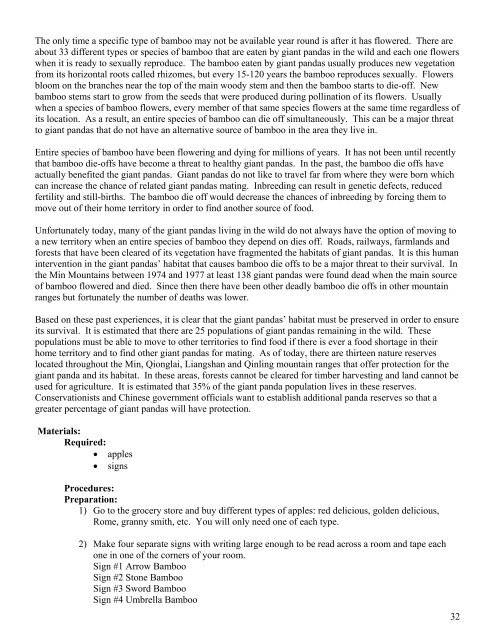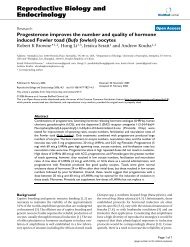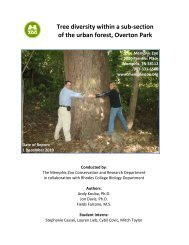Giant Panda Teacher Packet - Memphis Zoo
Giant Panda Teacher Packet - Memphis Zoo
Giant Panda Teacher Packet - Memphis Zoo
- No tags were found...
Create successful ePaper yourself
Turn your PDF publications into a flip-book with our unique Google optimized e-Paper software.
The only time a specific type of bamboo may not be available year round is after it has flowered. There areabout 33 different types or species of bamboo that are eaten by giant pandas in the wild and each one flowerswhen it is ready to sexually reproduce. The bamboo eaten by giant pandas usually produces new vegetationfrom its horizontal roots called rhizomes, but every 15-120 years the bamboo reproduces sexually. Flowersbloom on the branches near the top of the main woody stem and then the bamboo starts to die-off. Newbamboo stems start to grow from the seeds that were produced during pollination of its flowers. Usuallywhen a species of bamboo flowers, every member of that same species flowers at the same time regardless ofits location. As a result, an entire species of bamboo can die off simultaneously. This can be a major threatto giant pandas that do not have an alternative source of bamboo in the area they live in.Entire species of bamboo have been flowering and dying for millions of years. It has not been until recentlythat bamboo die-offs have become a threat to healthy giant pandas. In the past, the bamboo die offs haveactually benefited the giant pandas. <strong>Giant</strong> pandas do not like to travel far from where they were born whichcan increase the chance of related giant pandas mating. Inbreeding can result in genetic defects, reducedfertility and still-births. The bamboo die off would decrease the chances of inbreeding by forcing them tomove out of their home territory in order to find another source of food.Unfortunately today, many of the giant pandas living in the wild do not always have the option of moving toa new territory when an entire species of bamboo they depend on dies off. Roads, railways, farmlands andforests that have been cleared of its vegetation have fragmented the habitats of giant pandas. It is this humanintervention in the giant pandas’ habitat that causes bamboo die offs to be a major threat to their survival. Inthe Min Mountains between 1974 and 1977 at least 138 giant pandas were found dead when the main sourceof bamboo flowered and died. Since then there have been other deadly bamboo die offs in other mountainranges but fortunately the number of deaths was lower.Based on these past experiences, it is clear that the giant pandas’ habitat must be preserved in order to ensureits survival. It is estimated that there are 25 populations of giant pandas remaining in the wild. Thesepopulations must be able to move to other territories to find food if there is ever a food shortage in theirhome territory and to find other giant pandas for mating. As of today, there are thirteen nature reserveslocated throughout the Min, Qionglai, Liangshan and Qinling mountain ranges that offer protection for thegiant panda and its habitat. In these areas, forests cannot be cleared for timber harvesting and land cannot beused for agriculture. It is estimated that 35% of the giant panda population lives in these reserves.Conservationists and Chinese government officials want to establish additional panda reserves so that agreater percentage of giant pandas will have protection.Materials:Required:• apples• signsProcedures:Preparation:1) Go to the grocery store and buy different types of apples: red delicious, golden delicious,Rome, granny smith, etc. You will only need one of each type.2) Make four separate signs with writing large enough to be read across a room and tape eachone in one of the corners of your room.Sign #1 Arrow BambooSign #2 Stone BambooSign #3 Sword BambooSign #4 Umbrella Bamboo32





![Download the Teton Trek Presskit [PDF] - Memphis Zoo](https://img.yumpu.com/50103993/1/190x245/download-the-teton-trek-presskit-pdf-memphis-zoo.jpg?quality=85)










